This spring 2023 semester of EC&I 831, Social Media and Open Education, was very different than my initial visualizations when I first read the course synopsis. My first impression was that there would be a more prevalent focus on academic rigour, which I had taken to be the norm for most courses (this is a graduate-level course… of course). Instead, it diverged: blogging and posting! Chatting and sharing! Social media as an assignment! It’s been very different than my expectations, but I’m glad it’s been. I have never been much of a blogger or overall sharer of my progress with something, so it took some time to adjust to the structure. With this summary of learning, I felt it appropriate to continue with the blogging format, as it is something so different than other formats I’ve used thus far in my graduate program, such as presentations and video recordings. Continue reading
Open education: tons of potential, but does it let governments off the hook?
In our #EC&I831 course, we recently had a guest speaker, Alan Levine (@cogdog on Twitter), join us to talk about open education. In short, the essential understanding is that education and education resources have an opportunity to become more open-sourced, and not limited to the prescribed resources of the day. The conversation was intriguing, as a lot of what was discussed is also prevalent in my own teaching practices: resources losing relevance, and a struggle to find quality replacements or supplements for them. I can’t be the only one to experience this, so in that sense, this conversation could be relevant to all teachers.
In addition to this week’s meeting, I perused some additional resources related to open education. I had a listen to Lawrence Lessig’s TED talk, “Laws that Choke Creativity”. His premise, that society can combat the idea of a “read-only culture.. a culture which is top-down, owned, where the vocal chords of the millions have been lost” (1:08), can be seen in the efforts surrounding open education. Alan’s idea that education can be truly free and available for everyone rings true here, as well.
Now, having said that, I tend to always think about these ideas can actually play out. The more I think about open education, a couple, perhaps unfounded, concerns pop up. First, with the emergence of all sorts of different educational tools and strategies, I wonder if there is a possibility the education actually becomes less cohesive, and potentially even more inequitable, if there are too many different pathways to try to navigate. I’m not saying this because of a sense of self-preservation for the teaching profession, I suppose my concern is that the value society has of the entire education sector decreases.
This leads me to my second point: if the onus is on individual teachers to find, curate, and perfect the entirety of their teaching resources, I feel this may let provincial governments, who are supposed to be responsible for provisioning school divisions, and by extension, teachers, with the resources needed for their success, off the hook. I can’t back this up with any supplemental evidence, and I’m not going full conspiracy-theorist, but it’s something I wonder about as educational resources continue to be revised and made openly available. I use some of these myself (I’ve used CK-12 many times, for example), so I’m not advocating for minimizing the open education future. I just hope that we, as teachers and society at large, can make the most of the open education movement while still enshrining the capacity of teachers and the public education sector to give every student the means to develop as young people with positive futures ahead of them.
Reflecting on my gardening social media/learning experience
As this spring term’s EC&I 831 course draws to an end, I’ve been reflecting on how the parameters of the course shaped my overall direction in planning, organizing, and facilitating growing a backyard garden. It also had me reflect on my comfortability with social media, in general.
First, my thoughts on how this project went. I chose gardening as my focus for a couple reasons. It’s something that I’ve played a minor role in here at home, with my wife and her grandmother doing the vast majority of it. I mentioned in my beginning post that with my wife’s grandmother stepping back, I took this as an opportunity to step in more directly. But I also knew I needed to look at this as something more than just following the directions that have been followed before. I felt this would be a good opportunity to compare what I knew beforehand to what I could gain by maximizing social media tools.
But I’ll admit, I don’t think my social media implementation was as effective or far-ranging as what could have been idealized. I found early on, just in my experience, that Instagram failed me. I don’t have much experience with Instagram to begin with, but I found it lacking when it came to trying to find some semblance of community or previous discussion on the topics I was looking for. It seems more of a show-off space, for lack of a better term, and much of what I found wasn’t very relatable to what I was building. So, scratch this tool off the list.
Twitter surprised me, though again, maybe it’s more my implementation than any shortcomings itself. I used Tweetdeck to try to find related threads or conversations, but many of the results seemed to come from businesses advertising their services, and less in terms of community discussion or collaboration. Again, I’m not prepared to full-on abandon Twitter (I use it for many other things, still, so I know it can be effective), but I don’t think it benefited here as much as it maybe should have.
I tried to avoid using Facebook or YouTube, as these are services I’m most familiar with (Facebook), and might otherwise feel like cheating (YouTube). I found Reddit came to the rescue. I liked that the discussions and conversations are easily findable and are hosted in subreddits that are full of related discussions. Reddit came in clutch, for sure.
Now, reflecting on my own contributions or discussions. I’ll openly state that my own contributions or submissions using social media have not been overly numerous. When it came to questions I had throughout the project, such as the ideal quantity of berry bushes to plant together, or how to generally organize where certain plants should be planted in the garden, I sought out previous conversations, rather than ask my own. My general thinking has been that nothing I’ve been doing throughout this project is particularly novel, so certainly the questions I’m asking have been answered before.
Knowing this, I’m not sure I’m the greatest determiner of the effectiveness of social media in education. I’ve learned a lot throughout this project, and the course in general, and I found every topic interesting and engaging. I’d say the biggest roadblock I had in this project is myself, and my hesitation in maximizing my effective usage of the different social media tools available (for instance, I never created a TikTok account to check things out there).
However, I also know that I’ve opened a door regarding my mindset towards social media in education, and that door won’t be closing with the conclusion of this course. I know there are a plethora of learning opportunities to be found, and I just need to continue nudging myself towards those opportunities. In that sense, I look forward to continuing my own education towards better utilizing these social media tools.
Rain: much needed, gratefully accepted, but please don’t flood!
Water has been such a fickle thing throughout this garden experience. It has seemed like the rain offerings have been either feast or famine; downpours at a time, followed by long periods of dry heat. My experience with growing plants, including grass, has always involved the concern of over-or-under watering. I’ve always struggled to determine the ideal quantity of water that should be present in a growing space. But then Mother Nature goes ahead and takes that worrying out of my hands, so in a way, that’s good!
(I don’t say this to complain. My stakes are FAR lower than those of farmers and other agricultural participants.)
As I write this, we just experienced a major downpour this evening, including a small amount of hail (seemingly the first this season). The rain is absolutely helpful, don’t get me wrong, but I also know I pretty much won’t be entering the garden for the next several days. While at this point I hope the plants have grown enough that they won’t be completely swamped by the quantity of rain, I also know there isn’t much I can do right now if they were. Such is the waiting game at this point, I suppose.
Aside from the moisture considerations, there’s also the above-ground cleanup following such a heavy rain that must also take place. The garden is heavily inundated with all sorts of by-products from nearby treees, including full-on branches and such. The pictures below illustrate the point:
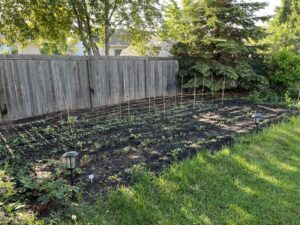


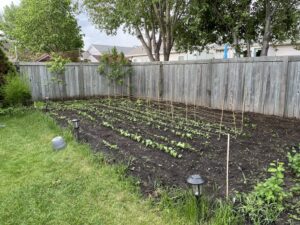
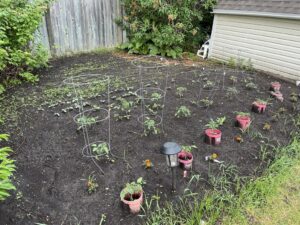
For added dramatic effect, take a look at our new backyard beach from our last downpour (the sand box was covered with a tarp, so this is not the full quantity of water that had rained):
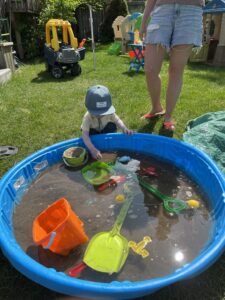
I’ll update this post tomorrow with pictures of the latest swamping. The purpose of this post, I’d say, is more of a commentary about how despite all our plans, nature still has the final say in the success of our growing projects. At least we haven’t experienced true hail yet! #blessed
Replacing the Saskatoon berry bush. Plus, an addition
As mentioned in my previous blog post, we suffered a loss in our garden: one of our three Saskatoon berry bushes succumbed to the voracious eating habits of an ant colony. The solution I used, the borax/sugar mixture, seems to have worked well! I guess the idea with this mixture is the borax does the heavy lifting, but ants aren’t inherently attracted to it, so this is where the sugar comes into play. In observing the area we discovered the garden ants, there are no longer the high number that was found earlier, though there still are some individuals bandying about, so I’ll continue with the mixture for the time being. It doesn’t harm the plants or produce, so that’s good.
Here are a couple sources I found that support the use of borax in dealing with ants:
Terminix: Borax for Ants: An Effective DIY Treatment?
Ant Killer with Borax: Yes, It Really Works!
It’s all well and good that we seem to have the ant problem figured out, but this didn’t solve that we are down a berry plant. Our hope when we planted them was to have yielding plants within three years or so, and maintain long-term growth and harvest at that point. During the summer, we camp up in Meadow Lake Provincial Park, and one of our pastimes is to go Saskatoon berry picking. We’re hopeful that these berry plants will provide us some additional yield, but not if the ants keep killing the bushes!
It’s a good thing that Costco exists. We purchased our original bushes from there, and it’s where I got our new replacement. But I didn’t leave with just the one. For whatever reason, I figured we could supplement the Saskatoon berries with a traditional blueberry bush. I just wish I had learned a little more about blueberry bushes beforehand? Why? It turns out that blueberry bushes are not self-pollinating (such as raspberries, of which we have a bush in our backyard), and therefore, like the Saskatoon berry bushes, will heavily benefit from several of the same plant in the vicinity. So… hopefully the bees are active!
Here’s an article from everyone’s favourite channel, HGTV, about how to effectively plant blueberry bushes. I sure wish I thought about this first…
I went ahead and planted the new blueberry bush anyways. The Saskatoon bush will likely grow more successfully as it has two other established buddies in its midst.
Planting was straightforward: dig holes deep enough for the bush transfers, move the bushes into their new locations, fill in with soil, and provide plenty of water.
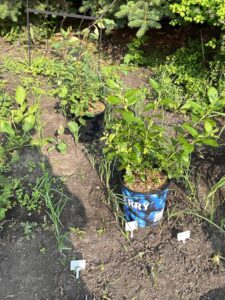

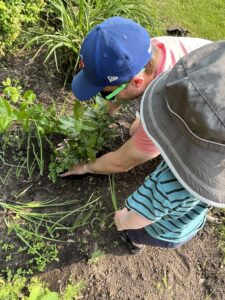


With these planted, hopefully they will grow into healthy, berry-yielding bushes.
Weeds and ants
The garden has been planted for a couple weeks, and by this point I am beginning to notice that the clean, pristine soil space that had been tilled, lined, and planted, isn’t looking quite the same. Namely, this seems to be the point that weeds and other inconvenient growths are starting to emerge, even after the soil was initially cleared and tilled. We aren’t going to chance using any sort of chemical product, so manual labour it is!
There hasn’t been much to research about this, just a matter of getting into the garden and cleaning out weeds. I focused on making sure the aisles between different rows were cleaned up. The pictures below will illustrate that.

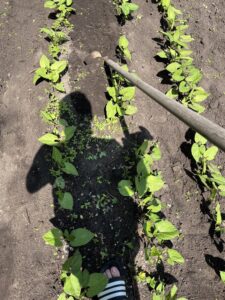
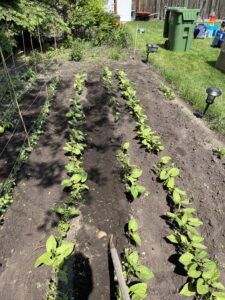
The pictures here help showcase the kinds of growth being found, and my efforts to basically pluck the root systems out of the soil.
A more difficult problem was also discovered: ants.
We’ve had ants before, but they’ve typically been found around the concrete perimeter of our house, and I’ve easily managed them with the aid of chemical product. But this week we discovered the presence of a sizable colony in the backyard. Rather than say hello to us, they decided to strike first. We’d been wondering for awhile now why one of our three Saskatoon berry bushes hadn’t appeared to grow this season, compared to the other two beside it. Unfortunately, the bush had been taken over by ants. When I dug up the bush (we accepted that it wasn’t going to grow), we found a large presence of ants below.
My first solution was to boil water in a kettle and unleash sweet justice upon them. After creating a boiling wet soil soup, and hoping that my work flooded some part of their network, I had to figure out a more effective solution. Typically, I just go with a Google search. In the spirit of this course, however, I tried to relegate my answers to those found through social media sites.
I’ve said it before and I’ll say it again: I’m not entirely sure what the purpose of Instagram is. It doesn’t seem to be much of a source of discussion or comparison, and it wasn’t much help in this regard. When I search “ant garden control” what popped up was mostly business advertisements and varieties of basic infographics, but nothing in the way of video exemplars or demonstrations. Moving on to Twitter, I used Tweetdeck to search for garden ant management, but again, not much came up. Is gardening not something very popular on social media?
Still determined to avoid YouTube, I tried Reddit. I’ve used Reddit for years, but not for anything related to gardening. A quick search for ant garden management helped me find this page. I’ve heard of using a borax/sugar mixture for dealing with ants, so this is what I went with. I made the mix and applied it around the region where the ants have been most active. Hopefully this helps!
As far as lessons to be learned through this period of the course, I would say I still struggle with maximizing the effectiveness of Instagram and Twitter, but this could also be due to gardening not necessarily being a hot topic of the platforms. As new questions pop up throughout my gardening experience, I’ll keep this in mind as I continue to try exploring these platforms in greater detail.
Step one to a garden… the rototilling
With the weather consistently staying at a nice temperature in May, it was time to get the garden set up. As the pictures will show, we have a large garden in our backyard, segmented into two parts. One side tends to receive more sun exposure but is smaller, so the plants in this section will include carrots, tomatoes, and beets. The larger section lends itself to the larger plants, such as bean and pea plants, as well as potatoes. In between the sections, we have a spruce tree and a collection of flowering plants. Also in the middle is our newest addition from last year: three Saskatoon berry bushes. Why three? Besides the desire for a larger yield, planting several bushes together will aid in cross-pollinating, and therefore promote greater growth and durability. Here’s hoping!
I mentioned in my first learning post that my wife and I have had this garden since we purchased our home. I also mentioned that my role in it has been minimal: gardening is my wife’s grandmother’s pastime, dating back to her time on their farm growing up. Our house, and the garden that came with it, was actually purchased by us from my wife’s grandmother. Thus, when we moved into our house, the garden became an experience between my wife and her grandmother. My only role in the process has been rototilling the garden. But with my wife’s grandmother being less physically able to actively participate in the garden, it’s up to me to step in and help. Fortunately, this provides me the chance to connect this to the EC&I 831 project.
We have a basic garden rototiller that I run prior to seeding the garden. Prior to the tilling, we’ve always cleaned out the garden first (a good practice) and then dumped several bags of triple-mix soil blend and manure. My wife’s grandmother’s rationale was that the soil in these parts is not of a particular high nutrient quality, so she always supplemented for every season. Delving deeper, we can justify the rototilling process by pointing to the benefits of aeration, weed prevention, and soil balance (via https://www.troybilt.com/en_US/knowledge-tb-benefits-of-tilling.html).
Rototilling isn’t particularly difficult, just physically tedious. It always starts with a 15 minute process to get the rototiller running after a season of sitting in the shed. Prime, pull, sigh, repeat. Eventually, it’s up and running, and I can till lines up and down both sections of the garden. Along the way, I tend to dig up roots, un-harvested produce from the previous season, and the occasional peanut buried by a bird.
Here is one side of a freshly-rototilled garden, complete with added triple-mix and manure.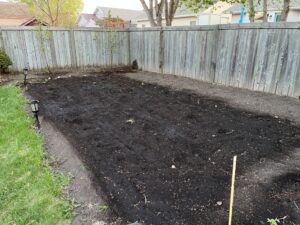
After the tilling came the actual planting. We planted all sorts of seeds: beans, peas, carrots, zucchini, tomatoes, potatoes, beets, lettuce, spinach, and others that I’m sure I forgot. We relied on a garden map devised by my wife for organizing where everything was to be planted. Not everything will be planted today, but at least the rows are complete.
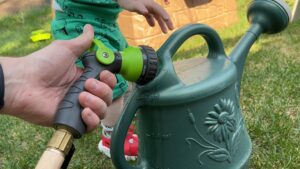 (Here’s a brief little video of us watering the start of our garden.)
(Here’s a brief little video of us watering the start of our garden.)
After the initial planting, the final step for the day was to give them a good watering. For now, I just used a watering can for each row, rather than the full hose.
With this out of the way, the next step will be to finish planting some of the more accessory plants, and then get into the maintenance pieces. On the way soon, based on previous years, will be an army of ants, aphids, and so on, all seeking to munch on our produce. In addition, with our son, Ben, now wanting to wander all around the yard, we’re going to have to be much more particular about the substances we use to help treat and protect the garden. There’s going to be a lot of research to follow.
Can online social media activism be meaningful and worthwhile?
Oh, boy. This one is tough!
My thoughts on social media activism have bounced around so many times, almost depending on the cause each time. I think social media can be a powerful tool, but I’m unsure if it can consistently deliver actionable results.
There are, of course, many successes. Pulling from this website (https://online.maryville.edu/blog/a-guide-to-social-media-activism/), we can see several movements that leveraged social media to help further propel the impacts. For example, the Arab Spring is often cited as one of the first major movements exposed by social media. Being able to share what is being experienced by people in the affected countries, live and unfiltered, helped reveal the struggles of people in a place that is, I would say, not as appreciated by the world at large, and saddled with negative stereotypes and misconceptions. These are real people, experiencing real hardships, and are striving to take action and make their country better.
Some activist movements seem primarily social media-driven. For example, the ALS Ice Bucket Challenge revolved around people being recorded doing some sort of skit or action to pour ice bucket water on them, making sure to note the goal is to raise awareness and funds for ALS research. I remember the first round of posts and shares all made mention of ALS, but as the challenge progressed, more people seemed to do it for the “viral” piece, not so much the ALS piece. To me, a distinct example of this was when some notable NHL players began participating in the ice bucket challenge, but not making note of the ALS research/cure focus. I remember the video put out by Jonathan Toews, then of the Chicago Blackhawks (and also the captain during and after the Kyle Beach incident), where he said something along the lines of “here’s my ice bucket challenge”, but nothing related to ALS. It seemed to highlight that as a social media campaign progresses, it eventually loses sight of it original meaning and intent. Kind of like the game “Telephone”.
Despite this, I do think it’s important, especially as educators, to make sure that conversations surrounding social justice are open and easily viewable. I think by consistently doing so, such topics and efforts become normalized. There’s certainly resistance to this notion, however, such as the bandying about of the word “woke” as some sort of negative connotation. I believe there is value in questioning why some people view “woke” negatively. I wonder at times if it’s understood what woke means? It doesn’t help that social media sites seem to use their algorithms to stimulate argument and disagreement, and not so much conducing of collaborative dialogue and consensus-building.
Reading this over, this all seems like a bunch of rambling just to conclude that my answer is “yes…maybe…with some work involved?”. I think social media is a powerful tool, that if properly leveraged, can be used to promote social justice and equity. It’s already used to sow anger and discontent in many circles, so why can’t it instead be used to model positive social citizenship? I think it can.
My time with Twitter
If someone ever goes to my Twitter page (@brayden_ursaki) and checks my date of sign-up, they might consider me to be a veteran. I apparently made my account in 2011, which means I was just out of high school and must have been experimenting with it. I don’t remember much of it from back then, to be honest, and I don’t think I ever posted anything. I’m grateful for that, because years later, I attended a PD session facilitated by my school division and it was an early version, of sorts, of this course. We were exploring some basic possibilities with social media in education, and at one point, we were asked to create a Twitter account, if comfortable, and make a related post. A colleague searched for my account and found it before I remembered I already had one, and I am so glad there was nothing there for him to see (my Facebook was cleaned up before I started adding profession-related friends, unlike the Twitter account).
Jumping into Twitter has its pros and cons. First, it is infinitely engaging, constantly finding new conversations to explore, and I like that it is primarily discussion-based, rather than content posting. I’ve made some basic posts and re-tweets, and I like that I can use both “likes” and “bookmarks” to keep track of things I want to preserve, based on whether I want others to see as well or not. In addition, it seems to be the social media site with the largest teacher presence. The quality and quantity of resources, strategies, and overall learning I’ve been able to find has greatly expanded my perspectives on education.
However, I do notice problems with the site. First, the algorithm. I’m learning that if I so much as have liked a post or comment from a category not related to education, my “for you” tab will reflect that potential interest. This is all well and good if it’s something generally benign, such as sports. However, there is such a seedy, negative, and downright combative side of Twitter commentary that I’ve found to be mentally draining at times. I’ve learned that if I want my feed to be primarily education-focused, I need to make sure my follows and likes stick to people in those topics. I’ve found desktop-based sites such as Tweetdeck massively help with streamlining my feed, but when using the Twitter app (which is the majority of the time), it just shows everything it can.
Overall, I’m happy there is a large community of educators on Twitter. It’s definitely been the tool I’ve used most often, and I’ve found that I hear about new educational trends or ideas before many other staff members in my school. When these same ideas pop up in our school conversations and meetings a few weeks or months down the road, I almost feel like a prophet (sooort of…).
Thinking about Instagram for Education
As mentioned in my earlier post, I am far from a social media power user. My experience with social media revolves around Facebook and Twitter. Twitter, in particular, has been engaging in the sense that it appears to be a highly-populated site for educators and all sorts of conversations, resource sharing, and so on within the education sector. I am decently well-versed in the educational possibilities of Twitter, so instead, I decided to give Instagram a look.
First, a couple preconceived notions. I’ve long struggled to differentiate Instagram from Facebook, but it appears to be more of a content sharing format than link aggregator or sharing of posts, as Facebook would be. To view the experience from anew, I created a new Instagram account. I didn’t get far, however, without automatically being temporarily suspended, apparently under suspicion of botting. Fortunately, by providing more private information about me, Instagram felt much more comfortable with me. Of course it did…
Jumping in, it appears I can’t get far without following people. There also doesn’t appear, early on, to have groups or things like that. However, it does seem like I can click on the “explore” tab or search for specific topics. In this case, I typed in “education” and selected one of the suggestions, “education system”. The page loaded to reveal a continuing stream of pictures and videos related to the topic. Clicking on any of them revealed the comment provided by the poster, and additional comments from other people. It seems really easy to contribute.
Thinking about how this could be utilized for education leaves me a little uncertain about its efficacy. First, it seems like Instagram is unusable if one doesn’t have or create an account. As a teacher in an elementary school setting, I don’t think it’s very reasonable to ask students to create or contribute an account, so already the student-facing component seems out of the question. Thinking about my own purposes, it certainly seems like a useful tool for posting content. It does seem a little less conducive towards conversation or the provision of external links or resources. It does seem very consumption-focused, and more about what gets posted than the engagement with it, at least from my limited experience with it.
After this brief experimenting with a fresh Instagram experience, I would comment that its education-related applicability seems more limited than other mediums, such as Twitter. It doesn’t seem as conducive towards conversations between teachers, as it doesn’t have things such as threads, and the way it handles external links seems clunkier than Twitter. Overall, it might be a decent secondary content viewing tool, but ultimately less than Twitter.
